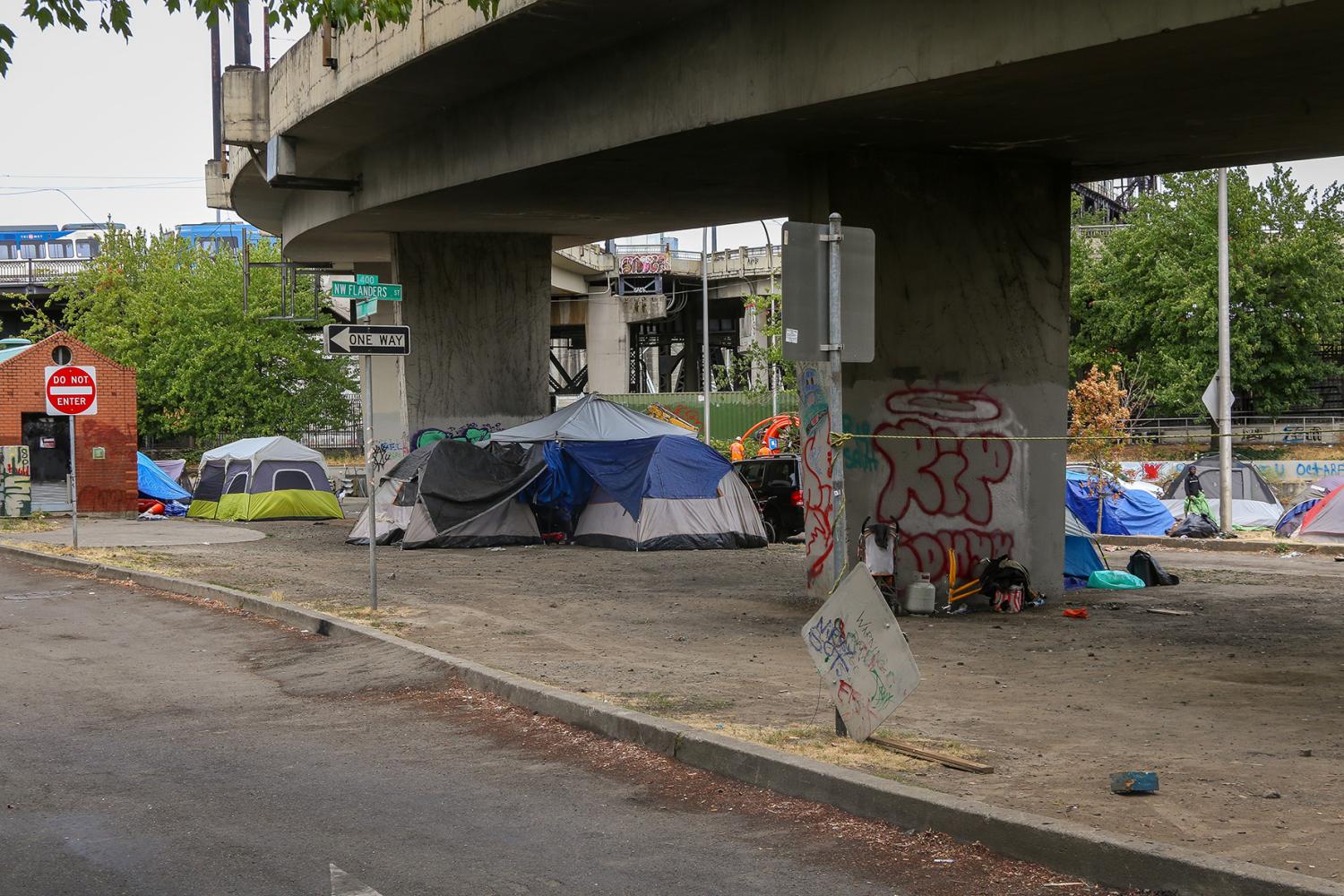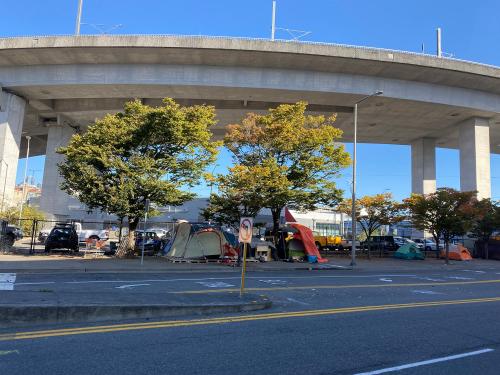Last month, volunteers across the United States braved frigid temperatures to conduct the Department of Housing and Urban Development’s annual point-in-time (PIT) count, which tallies the number of people experiencing homelessness in a community. As the numbers are added up, it’s important to ask: What is the nation learning from this data? And more importantly, how are local leaders using it to craft more effective and humane homelessness policies?
Late last year, we published an in-depth analysis of pandemic-era homelessness trends in major U.S. cities and found a complicated picture: While homelessness was up significantly over the last decade in some cities, such as Seattle, others major cities, including Chicago, New York, and Philadelphia, saw meaningful and sustained declines. Our research made it clear that there is no “one-size-fits-all” barometer for understanding America’s challenge with homelessness, and instead, paying attention to regional variations in homelessness trends can help policymakers understand what’s working to reduce it.
This piece provides an updated analysis of homelessness in U.S. cities using the most recently published PIT count data, from 2023 (data collected in January 2024 will not be released until the end of the year). We once again find a nuanced patchwork of trends across cities and regions that reveals stark new challenges in some cities (e.g., New York), but also bright spots of success in reducing homelessness in others (e.g., Austin, Texas and Indianapolis). These findings make it clear that cities have the evidence and tools at their disposal to reduce homelessness—there just needs to be the political will to invest in and scale them.
As Jeff Olivet, executive director of the U.S. Interagency Council on Homelessness, told us while participating in Washington, D.C.’s PIT count last month, “What we do tonight matters, but what we do tomorrow matters more.”
Place matters for understanding homelessness in the US
The national picture of recent homelessness trends is grim. The U.S. overall saw a 12% increase in homelessness between 2022 and 2023, with a 15% increase in major cities. But looking more closely at the trends, there are some bright spots.
In nine out of the 44 major cities that completed full PIT counts in 2023, homelessness rates either remained stable or declined between 2022 and 2023, with rates in Austin, Texas, Raleigh, N.C., Indianapolis, and Colorado Springs, Colo. declining over 10 percentage points. On the other hand, New York, Albuquerque, N.M., Portland, Ore., Atlanta, and Boston saw sharp increases in total homelessness.
Of the four cities we examined more closely in our original report (Chicago, New York, Seattle, and Philadelphia), stories of both progress and setbacks emerge (Figure 1). Last year, our findings revealed that despite perceptions of rising homelessness in these cities, total homelessness rates had declined over the last decade in three of the four: Chicago (42% decline), Philadelphia (25%), and New York (16%). Seattle was the outlier, with total homelessness increasing by 23% and unsheltered homelessness by 88%.
Between 2022 and 2023, however, we found that while longer-term trends remained relatively consistent in three cities, New York saw a 42% increase in total homelessness over that year (Table 1, Column 3)—the biggest spike in the country in absolute terms (an additional 314 homeless people per 100,000 population). This partially reflects the large influx of international migrants to the city since spring 2022, but also the primary root cause of homelessness: high housing costs and low inventory, particularly of affordable units. Chicago also saw its total homelessness population increase between 2022 and 2023, but the city has still exemplified a story of progress over the long term, with homelessness falling by 7% since 2015 and unsheltered homelessness falling by 51%, including progress in the most recent year.
Looking at the larger picture of short- and long-term total and unsheltered homelessness trends, it’s clear that there are pockets of both progress and setbacks in U.S. cities—reinforcing the need for upstream solutions that can meet cities and regions where they are.
The policies that work to reduce homelessness
The chief driver of homelessness in U.S. cities is inadequate housing supply. Thus, any plan to reduce homelessness requires increasing the supply of all types of housing, particularly affordable housing.
In addition, there are a number of short- and long-term policies that local leaders can embrace to target structural conditions associated with homelessness—spanning from reentry and workforce development programming to alternative crisis response models—while also building stronger regional economies. Below are five evidence-based recommendations for local leaders to more effectively reduce homelessness; for a fuller explanation of each recommendation, see our December 2023 report.
- Ensure that housing policy is homelessness policy. As a longer-term solution, local governments should align their housing, land use, and homelessness plans to increase the supply of all types of housing; remove barriers to affordability and shelter construction (such as single-family-only zoning, parking minimums, and parcel shape regulations); and adopt evidence-based “housing first” models. In the shorter term, cities should adopt and scale the pandemic-era preventative measures that helped avoid a spike in homelessness, including investments in emergency rental assistance, eviction defense, tenants’ rights, and economic stimulus, as well as mitigation measures such as converting hotels into temporary housing.
- Scale alternative crisis response models to better respond to people with behavioral health and substance-use emergencies while improving public safety. To better address safety concerns surrounding homelessness, mental health, and quality-of-life offenses, local leaders should adopt and scale non-police alternative crisis response models—following the evidence and successes from Denver, Eugene, Ore., and other cities. In doing so, they should take care to not only prioritize crisis response models that provide an alternative for low-level offenses (such as substance use or homelessness), but also include models that address intimate partner violence—an area where victims are disproportionately likely to experience homelessness as a result of the circumstances surrounding victimization.
- Strengthen housing and employment supports for those reentering communities after incarceration. To better address the cycle between incarceration and homelessness, study after study shows that bolstering reentry supports—particularly access to housing and employment—is critical to reducing recidivism and homelessness, while also improving public safety. Effective policies include reducing barriers for returning citizens to enter public housing; providing tailored services for those most at risk of homelessness prior to release (including workforce and housing supports); and explicitly addressing the unique needs of returning citizens in regional housing and homelessness plans, among other reforms.
- Leverage the capacity of place governance organizations to humanely address homelessness, particularly in central business districts. Place governance organizations such as business improvement districts (BIDs) have at times been complicit in the act of displacing homeless people and embracing hostile architecture. However, BIDs have also been innovative and effective partners in reducing homelessness by implementing inclusive management practices aligned with a public health approach, such as employing community ambassadors; providing access to drinking water and public restrooms; supporting placemaking activities and other built environment improvements that enhance safety, vibrancy, and belonging in the public realm; and connecting residents to social services, employers, and workforce development providers. BID leaders should follow these inclusive management practices and continue to partner with local governments and Continuum of Care providers to humanely address homelessness in downtown districts.
- Take a regional, data-driven approach to homelessness. To respond to the structural challenges that prevent people across a region—not just within city boundaries—from accessing affordable housing, there is a movement to establish regional homelessness authorities that correspond to merged, regional Continuums of Care and align resources and service delivery programs across a region. Regions should adopt this “regional approach” to homelessness and coordinate on cross-jurisdictional challenges to addressing homelessness by aligning regional funding, communications, coordination, social delivery infrastructure, data collection, performance management, training, and capacity-building.
“Behind every data point is a human life,” Jeff Olivet told us during last month’s PIT count. While the data we use to understand homelessness isn’t perfect, it is clear about one thing: Far too many human lives are being harmed by unequal access to stable housing, food, and services. A large, unsheltered homeless population does not have to be an inevitable part of cities. There are solutions at our disposal to not only respond effectively to the needs of people experiencing homelessness today, but to create the conditions that prevent homelessness tomorrow.
The Brookings Institution is committed to quality, independence, and impact.
We are supported by a diverse array of funders. In line with our values and policies, each Brookings publication represents the sole views of its author(s).





